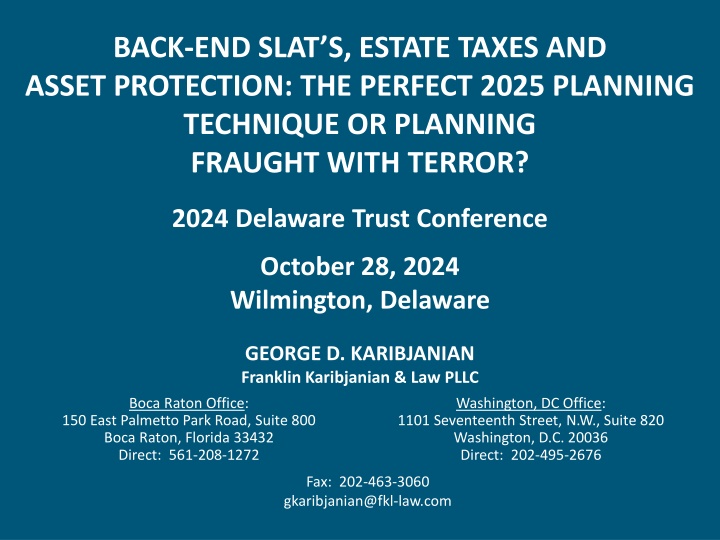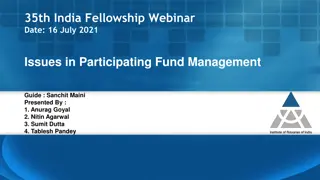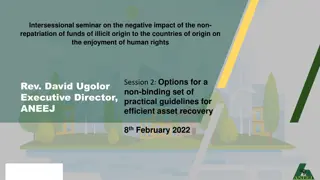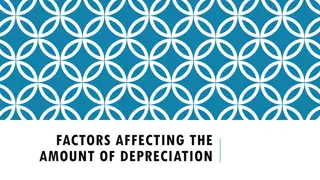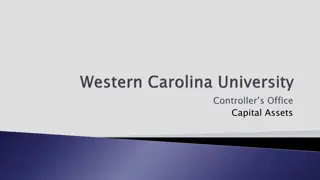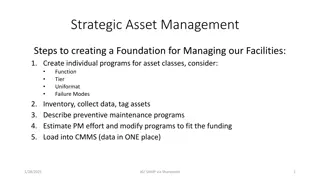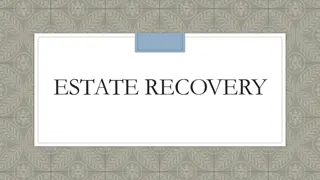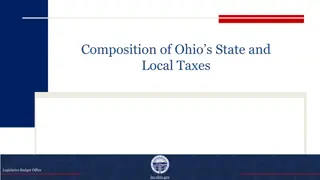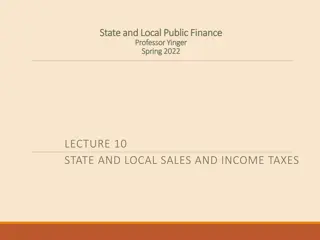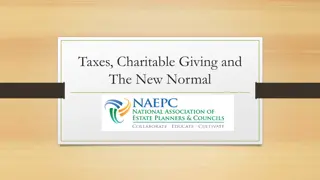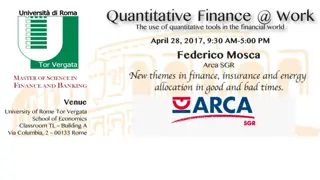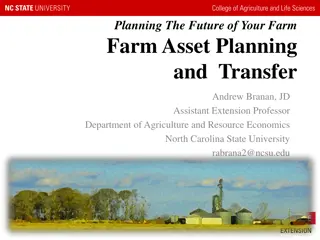Back-end Slats, Estate Taxes, & Asset Protection: The Perfect 2025 Planning Technique
George D. Karibjanian, a Board Certified attorney with extensive experience in estate planning, discusses the potential impacts of the Uniform Voidable Transactions Act on estate planning strategies. He has delivered numerous lectures and publications on topics such as same-sex estate planning, trusts, and estate taxation, showcasing his expertise in the field.
Download Presentation

Please find below an Image/Link to download the presentation.
The content on the website is provided AS IS for your information and personal use only. It may not be sold, licensed, or shared on other websites without obtaining consent from the author.If you encounter any issues during the download, it is possible that the publisher has removed the file from their server.
You are allowed to download the files provided on this website for personal or commercial use, subject to the condition that they are used lawfully. All files are the property of their respective owners.
The content on the website is provided AS IS for your information and personal use only. It may not be sold, licensed, or shared on other websites without obtaining consent from the author.
E N D
Presentation Transcript
BACK-END SLATS, ESTATE TAXES AND ASSET PROTECTION: THE PERFECT 2025 PLANNING TECHNIQUE OR PLANNING FRAUGHT WITH TERROR? 2024 Delaware Trust Conference October 28, 2024 Wilmington, Delaware GEORGE D. KARIBJANIAN Franklin Karibjanian & Law PLLC Boca Raton Office: Washington, DC Office: 1101 Seventeenth Street, N.W., Suite 820 Washington, D.C. 20036 Direct: 202-495-2676 150 East Palmetto Park Road, Suite 800 Boca Raton, Florida 33432 Direct: 561-208-1272 Fax: 202-463-3060 gkaribjanian@fkl-law.com
GEORGE D. KARIBJANIAN George D. Karibjanian is a Founding Member of Franklin Karibjanian & Law, a national boutique law firm based in Washington, D.C., with additional offices in Boca Raton, Florida and Naples, Florida. George is Board Certified by the Florida Bar in Wills, Trusts & Estates and is a Fellow in the American College of Trust and Estate Counsel. George divides his time between the Boca Raton and Washington offices, spending the majority of his time in Boca Raton. He earned his B.B.A. in Accounting from the University of Notre Dame in 1984, his J.D. from the Villanova University School of Law in 1987, and his LL.M. in Taxation from the University of Florida in 1988. George has practiced his entire legal career in South Florida (over 36 years), practicing exclusively in the areas of estate planning and probate and trust administration, and also represents numerous clients with respect to nuptial agreements. George has participated in over 225 formal presentations, either individually or as part of a panel discussion, to national, state-wide and local groups, and has over 80 publication credits in national and regional periodicals and journals. Born and raised in Vineland, New Jersey (in the heart of South Jersey), George has called Boca Raton home since 1988. When not attending Miami Marlins home games (that AAA-talent level franchise masquerading as a Major League Baseball team), George is any one or more of reading anything and everything regarding the entertainment industry or is keeping current and/or binge-watching television programming that skews way below his supposed demographic (think any of the BelowDeck franchises), way above his supposed demographic (think PBSMasterpiece ) and even in-between (think Only Murders in the Building ). George is fortunate to visit the Northern California wine region annually each March (courtesy of a recurring speaking engagement at the California Tax Bar s annual Estate and Gift Tax Conference in San Francisco). George s personal mantra is that he believes that internal satisfaction and contentment are not measured by professional or personal accolades or achievements put simply, if the Marlins mascot, Billy the Marlin, walks by his seats at LoanDepot Park, he considers it to be a win. Boca Raton Direct: (561) 208-1272 On the topic of the Uniform Voidable Transactions Act and its potential negative effect on estate planning, George has published many articles and has lectured in cities across the nation such as Las Vegas, Nashville, New York, Phoenix, Portland (Or.), San Diego, San Francisco, and Wilmington (Del.), and presented webinars to groups in South Dakota and Alaska. George has also presented on the topic in October 2016 at the 42nd Annual Notre Dame Tax and Estate Planning Institute in South Bend, Indiana. DC Direct: (202) 495-2676 On the topic of same-sex estate planning, George has lectured at various conferences and estate planning councils throughout the United States and has published numerous articles in publications such as Steve Leimberg s LISI Estate Planning Newsletters, Trusts & Estates Magazine and the Florida Bar Journal. George has also been quoted by several publications and websites. gkaribjanian@fkl- law.com George was presenter at the 48th Annual Heckerling Institute on Estate Planning in Orlando, Florida in 2014, speaking on a panel discussion titled, Living and Working with the Uniform Principal and Income Act, focusing on the tax effects on the power to adjust trust principal to income, the power to convert an income trust to a unitrust, comparing the various unitrust statues and focusing on potential litigation facing fiduciaries in this area. George s other lectures have included topics such as Portability, Decanting, Trustee Selection and Duties, Current Developments in Estate Planning and Taxation, Representing a Client with Potential Capacity Issues, Whether a Supplemental 706 is Required, Inter-Vivos QTIP Planning, Prenuptial Agreements for the Estate Planner, the Advantages and Disadvantages of Domestic Asset Protection Trusts and Differences in the States Version of the Uniform Trust Code. For the American Bar Association s Section of Taxation, he is a past Co-Chair of the Estate and Gift Tax Committee; was the Chairperson for the Section s 2016 Comments on the Basis Consistency Regulations, the Chairperson for a 2011-12 Section Task Force Subcommittee Advocating Changes to the Portability Provisions Added by the 2010 Tax Act; and a contributing draftsman to the Section s 2012 Comments on decanting. For the American Bar Association s Section of Real Property Trusts & Estates, Income and Transfer Tax Planning Group, he is a current Co-Chair of the Generation-Skipping Tax Committee within the Income and Transfer Tax Planning Group, and has served as a Co-Chair or Vice-Chair of several other committees. He is also a member of the CLE and eCLE Committees. For the Florida Bar s Real Property Probate & Trust Law Section, he is a past Chair of the Asset Protection Committee; the Co-Vice Chair Probate & Trust and National Events Editor for the Section s ActionLine publication from 2012 - 2022; the Co-Chairperson of the RPPTL Ad Hoc Committee regarding potential statutory changes in light of a change in Florida s DOMA laws; a member of the Ad Hoc committee to study changes to Florida s decanting statutes (which led the 2018 legislation enacting the suggested changes); the Chairperson and primary draftsman of the Section s 2012 comments to the IRS on decanting, a member of the RPPTL Ad Hoc Committee that drafted a statutory change in response to Florida s Morey v. Everbank decision; and a member of the Section s Executive Council from 2012 - 2022. George is also a member of the Greater Boca Raton Estate Planning Council and the South Palm Beach County Bar Association. George currently serves on the Professional Advisory Committee for George Snow Memorial Scholarship Foundation. Previously, George served on the Professional Advisory Committee for the Boca Raton Museum of Art from 2011 to 2019 and served on the Board of Directors for the Palm Beach County Wealth & Estate Planning Seminar from January 2015 until its suspension in January 2019. George also served as President and a member of the Board of Directors of the Notre Dame Alumni Club of Boca Raton (1996-1997), a member of the St. Jude's Church (Boca Raton) Financial Education Council (1994-1996), and Vice President and a member of the Board of Directors of the Boca Raton Girls Fastpitch Softball Association (2004-2008). 2
A. Introduction Exploring the Back-End SLAT Mining Valuable Estate Planning Riches or Merely Mining Fool s Gold? 47 Bloomberg Tax Management Estates, Gifts and Trusts Journal 6 (11/10/22) Asset Protection is a Controversial Topic Any time that the topic of discussion is asset protection, the topic suddenly becomes controversial. Which is understandable when most people think of asset protection, they immediately think of the unscrupulous wealthy individual using off-shore trusts to hide assets. 3
A. Introduction Summary of the Presentation This Presentation will analyze the spousal lifetime access trust as a means to utilize the individual s basic exclusion amount (i.e., estate/gift tax exemption) while indirectly retaining the benefits what the Back End SLAT Statute, where an individual can create a spousal lifetime access trust ( SLAT ) for her/his spouse, and, upon the spouse s death, retain the possibility that, if the donor spouse survives the donee spouse, an interest in the trust can continue for the donor spouse, and how and why such an interest may not be subject to estate taxes in the donor spouse s gross estate for Federal estate tax purposes. 4
B. Overview of the Spousal Lifetime Access Trust History of the Basic Exclusion Amount As part of the Tax Cuts and Jobs Act of 2017, the BEA was doubled, albeit with a sunset occurring in 2026. For example, in 2020, the BEA was $11,580,000; in 2021, the BEA was $11,700,000; and in 2024, the BEA is $12,610,000. 5
B. Overview of the Spousal Lifetime Access Trust Techniques for using the BEA With the increases in the BEA and threatened decreases, taxpayers sought techniques whereby BEA could be used before it was reduced; a use it or lose it approach. Rather than just using BEA, taxpayers sought means by which the BEA could be utilized, but the taxpayer could still reap the benefits from the gifted property. The problem with retaining any benefits from gifted property were the potential inclusion back into the gross estate for either a retained interest under 2036 or a violation of the principles of Chapter 14 ( 2701 2704), which would potentially negate the benefits of the used exemption. 6
B. Overview of the Spousal Lifetime Access Trust Enter the Spousal Lifetime Access Trust, or SLAT Many of the techniques proposed would not allow the donor to reap the benefits of the gifted property; however, if the donor was married, one trust in particular was highly advantageous the spousal lifetime access trust, or SLAT. This seems complex is it? NO! The SLAT is nothing more than an inter-vivos Credit Shelter, Family or Bypass Trust! Commonly, in a SLAT, an irrevocable trust is created whereby the income and principal are payable to a class of individuals consisting of the spouse (the Donee Spouse ) and the settlor s (the Donor Spouse ) descendants; in other words, the same approach as would be used in a Credit Shelter Trust upon the Donor Spouse s death. 7
B. Overview of the Spousal Lifetime Access Trust Why a SLAT Works While the Donor Spouse has no beneficial interest in the SLAT, keep in mind that for the most part, married persons are often considered to be a single economic unit, meaning that the spouses share the income that each brings to the marriage. Because the income and principal can be paid to the Donee Spouse, because the Donor Spouse and the Donee Spouse are a single economic unit, the Donor Spouse shares in trust distributions to the Donee Spouse; therefore, the Donor Spouse can indirectly benefit from the property transferred to the SLAT and this would not violate any of the Code s retained interest provisions. 8
B. Overview of the Spousal Lifetime Access Trust Advantages Because spouses are considered to be a marital unit, the Donor Spouse can benefit from property gifted to the SLAT. Because the SLAT is a completed gift for gift tax purposes (i.e., no retention of a beneficial interest by the Donor Spouse to cause gross estate inclusion), any appreciation attributable to SLAT assets avoids estate taxation in the Donor Spouse s gross estate. No Gross Estate Inclusion as to Donee Spouse Because the SLAT is a completed gift by the Donor Spouse, and because it does not qualify for the marital deduction, the typical SLAT is also not included in the Donee Spouse s gross estate. 9
B. Overview of the Spousal Lifetime Access Trust Advantages (cont.) Grantor Trust SLAT s are grantor trusts, even if none of the grantor trust provisions within the 670 s (including, but not limited to, the retained power to substitute assets, the ability to borrow without interest or security, etc.) are included. A grantor trust provision that automatically applies is 677(a)(1), which provides that the grantor is to be treated as the owner of any portion of a trust (and therefore taxed on the trust income) if the income from the trust may be distributed to the grantor or the grantor s spouse 10
B. Overview of the Spousal Lifetime Access Trust Advantages (cont.) Grantor Trust (cont.) Who is the spouse ? Under 672(e)(1)(A), a grantor is treated as holding any power or interest of the grantor s spouse, which is defined as any individual who was the spouse of the grantor at the time of the creation of such power or interest (referred to informally as the Spousal Unity Rule ). Thus, under 672(e)(1)(A), if the Donor Spouse created a trust for the benefit of her/his descendants, but gave the Donee Spouse the right to substitute assets under 674(4)(C), the power in the Donee Spouse would be attributed to the Donor Spouse and cause the trust to be a grantor trust as to the Donor Spouse. 11
B. Overview of the Spousal Lifetime Access Trust Advantages (cont.) Creditor Protection The SLAT provides the trust beneficiaries with creditor protection as a third party trust, if the SLAT contains a typical spendthrift provision, creditors of the Donee Spouse and the other beneficiaries should not be able to reach the assets within the SLAT, and nor can the beneficial interests in the SLAT be attachable by such creditors. 12
B. Overview of the Spousal Lifetime Access Trust Disadvantages Death of the Donee Spouse If the Donee Spouse dies, the property passes to the SLAT remainder beneficiaries. As with the issues upon divorce, the Donor Spouse loses the indirect access to the funds held in the SLAT. Divorce If the Donor Spouse and the Donee Spouse cease to be married, unless the SLAT contains a death on divorce clause, the Donee Spouse remains a beneficiary of the SLAT and can continue to receive income and principal therefrom. 13
B. Overview of the Spousal Lifetime Access Trust Disadvantages (cont.) Divorce (cont.) Grantor Trust Status Even though the spouses are divorced, and technically the Donee Spouse is no longer married to the Donor Spouse, the SLAT remains a grantor trust as to the Donor Spouse. This result occurs as a result of the 2018 repeal of 682, which is effective for all marriage terminations occurring after December 31, 2017. 14
B. Overview of the Spousal Lifetime Access Trust Disadvantages (cont.) Can there be planning to avoid the results on divorce? Solution #1 Tax Reimbursement Clause Since the release of Rev. Rul. 2004-64, most grantor trusts will contain a provision allowing the Trustee to reimburse the grantor for income taxes incurred by the grantor as a result of grantor trust status. For this solution, the SLAT would provide that if the parties are divorced, the Trustee shall reimburse the grantor for income taxes paid by the grantor. Under those specific facts, the reimbursement clause would do more harm than good presumably, a mandatory reimbursement provision would cause the SLAT to be included in the Donor Spouse s gross estate as a retained interest under 2036. 15
B. Overview of the Spousal Lifetime Access Trust Disadvantages (cont.) Can there be planning to avoid the results on divorce? Solution #1 Tax Reimbursement Clause There is no guarantee to the Donor Spouse that reimbursements would be remitted, which would likely not give the Donor Spouse comfort. The solution would be that the Trustee would, at the Trustee s sole discretion, reimburse in the event of a divorce; however, if this occurs, this could be perceived as a pre-existing understanding that reimbursement would be given upon a divorce, and pre-existing understanding is an exception to the general rule of non-includibility under Rev. Rul. 2004-64. 16
B. Overview of the Spousal Lifetime Access Trust Disadvantages (cont.) Can there be planning to avoid the results on divorce? Solution #2 Terminate Grantor Trust Status By Adding an Adverse Party as Trustee The preamble to 677 provides as follows: The grantor shall be treated as the owner of any portion of a trust, whether or not he is treated as such owner under section 674, whose income without the approval or consent of any adverse party is, or, in the discretion of the grantor or a nonadverse party, or both, may be The preamble provides that the trust would not be considered to be a grantor trust if the income is distributable only with the approval or consent of any adverse party. 17
B. Overview of the Spousal Lifetime Access Trust Disadvantages (cont.) Can there be planning to avoid the results on divorce? Solution #2 Terminate Grantor Trust Status By Adding an Adverse Party as Trustee Adverse Party is defined in 672(a) as: (a) Adverse party. For purposes of this subpart, the term adverse party means any person having a substantial beneficial interest in the trust which would be adversely affected by the exercise or nonexercise of the power which he possesses respecting the trust. A person having a general power of appointment over the trust property shall be deemed to have a beneficial interest in the trust. 18
B. Overview of the Spousal Lifetime Access Trust Disadvantages (cont.) Can there be planning to avoid the results on divorce? Solution #2 Terminate Grantor Trust Status By Adding an Adverse Party as Trustee Practically speaking, an adverse party is someone possessing a beneficial interest that would be adversely affected by an action taken with respect to another person with a beneficial interest. The most common example of adverse parties would be an income beneficiary vs. a remainder beneficiary 19
B. Overview of the Spousal Lifetime Access Trust Disadvantages (cont.) Can there be planning to avoid the results on divorce? Solution #3 Death on Divorce Clause The SLAT could contain a variation of the death on divorce clause that provides that, upon a marriage termination, if an adverse party is not acting as the Trustee of the SLAT, an adverse party is to be appointed as a co-Trustee and that all decisions of the Trustees are to be made by unanimous consent. 20
B. Overview of the Spousal Lifetime Access Trust Disadvantages (cont.) Can there be planning to avoid the results on divorce? Solution #3 Death on Divorce Clause This seems like a workable solution; however, consider two important elements in drafting this provision: Does the planner represent both spouses? What if the remainder beneficiaries, who are usually the Donor Spouse s children, are all not of the age of majority such that there are no adverse parties who could act as a Trustee? 21
B. Overview of the Spousal Lifetime Access Trust Disadvantages (cont.) Can there be planning to avoid the results on divorce? Solution #4 Property Settlement Agreement Provides that Donee Spouse Reimburses the Donor Spouse for Income Taxes Under this approach, the Property Settlement Agreement between the parties provides that each year, the Donor Spouse will be reimbursed by the Donee Spouse for income taxes paid as a result of the grantor trust status of the SLAT. 22
B. Overview of the Spousal Lifetime Access Trust Disadvantages (cont.) Can there be planning to avoid the results on divorce? Solution #4 Property Settlement Agreement (cont.) Is the reimbursement income to the Donor Spouse? Appreciated Property If the property transferred is appreciated property, then no, there is no income as a result of 1041, which provides that property transferred that is incident to a divorce is not subject to gain or loss treatment; thus, no income is recognized by the Donor Spouse on the receipt (and the Donor Spouse receives a carryover basis) and there is no recognition on the transfer by the Donee Spouse. 23
B. Overview of the Spousal Lifetime Access Trust Disadvantages (cont.) Can there be planning to avoid the results on divorce? Solution #4 Property Settlement Agreement (cont.) Is the reimbursement income to the Donor Spouse? Cash Prior to 2018, cash payments would be reviewed to determine if such payments were alimony; if they were, then there would potentially be income recognition. However, with the repeal of 71 and 215, alimony is no longer income to the recipient, so such payments would not be income to the Donor Spouse. 24
B. Overview of the Spousal Lifetime Access Trust Disadvantages (cont.) Can there be planning to avoid the results on divorce? Solution #4 Property Settlement Agreement Provides that Donee Spouse Reimburses the Donor Spouse for Income Taxes What would be required? Divorces are not pleasant experiences. Period. Presumably, the Donor Spouse would have to provide her/his Federal income tax return by a specified date each year for review and approval by the Donee Spouse, which will likely not be a simple process. 25
B. Overview of the Spousal Lifetime Access Trust Disadvantages (cont.) Can there be planning to avoid the results on divorce? What about decanting to a new trust that is not a grantor trust as to the Donor Spouse? The trustee decants the SLAT to a new trust that would not be a grantor trust as to the Donor Spouse, i.e., no substitution power, no borrowing without adequate security, etc. The theory is that the transfer is made to a new trust at a time when the parties were no longer married, so this would arguably remove 677(a) from equation because the Donee Spouse would not be a spouse under 677(e)(1)(A). 26
B. Overview of the Spousal Lifetime Access Trust Disadvantages (cont.) Can there be planning to avoid the results on divorce? What about decanting to a new trust that is not a grantor trust as to the Donor Spouse? To the author, this solution would not work because the Internal Revenue Service would likely treat the new trust as an extension of the old trust with the same tax attributes, meaning, the Donee Spouse would still be considered to be the Donor Spouse s spouse for 677(a) purposes. 27
B. Overview of the Spousal Lifetime Access Trust Disadvantages (cont.) Can there be planning to avoid the results on divorce? Solution #5 Paul Lee s Post-Divorce SLAT Partnership This elaborate technique involves spouses that created reciprocal SLAT s, but at the time of divorce, have different assets with skewing built-in gain. The parties would have the SLAT s then exchange assets (through asset swaps and/or decanting) in order to equalize the effect (this exchange takes into consideration the effects of 677(a) so that no income is recognized on the exchanges). Once the equalization has been completed, the SLAT s form a new partnership, naming a trusted third person to be the general partner. 28
B. Overview of the Spousal Lifetime Access Trust Disadvantages (cont.) Can there be planning to avoid the results on divorce? Solution #5 Paul Lee s Post-Divorce SLAT Partnership On paper, while complex, this technique resolves many of the issues because each spouse would be taxed on exactly one-half of the income from the partnership, which negates the detrimental effect of 677(a). Further, given the complexity, this would not be a solution for smaller SLAT s, but, given the use of SLAT s to utilize BEA, the SLAT s involved would most likely be of a value in excess of $10,000,000 each so it would be worth the clients while to investigate the feasibility of this. Further, this approach only works if both spouses have created SLAT s. 29
C. Overview of the Back-End SLAT Introduction to the Back-End SLAT Focusing on the death of the Donee Spouse, the primary drawback to a SLAT is what happens if the Donee Spouse predeceases the Donor Spouse. Under the typical SLAT, if that were to occur, the SLAT then continues in further trust for the benefit of the Donor Spouse s descendants, in which case the Donor Spouse loses the use of the gifted funds. 30
C. Overview of the Back-End SLAT Introduction to the Back-End SLAT Why not just provide a continuing trust (the Resulting Trust ) in which an interest is created for the Donor Spouse (a Back-End Interest )? Because the trust benefits the Donor Spouse and the Donor Spouse created the trust, the trust is, in effect, a self- settled spendthrift trust ( SSST or DAPT (domestic asset protection trust)). As a DAPT, this could create adverse estate tax consequences to the Donor Spouse and negate the transfer tax advantages of the SLAT 31
C. Overview of the Back-End SLAT The Purpose for a Back-End SLAT Statute The Use of SLAT s SLAT s use the Donor Spouse s AEA while allowing funds to remain in the marital unit What happens if the Donee Spouse predeceases the Donor Spouse the Donor Spouse loses the use of the funds. If the SLAT creates a beneficial interest in the Donor Spouse, the SLAT becomes a self-settled spendthrift trust 32
C. Overview of the "Back-End SLAT The Purpose for a Back-End SLAT Statute Self-Settled Spendthrift Trust Doctrine As a SSST, the trust would arguably be includible in the Donor Spouse s gross estate because the Donor Spouse s creditors can reach the Donor Spouse s interest. The reachability is called the Self-Settled Spendthrift Doctrine 33
C. Overview of the "Back-End SLAT The Purpose for a Back-End SLAT Statute Self-Settled Spendthrift Trust Doctrine This is why states enact DAPT legislation; to prevent the implementation of the SSST Doctrine. Starting with Alaska in 1997, 20 jurisdictions have DAPT statutes. This means that 31 of 51 U.S. jurisdictions, or more than 60%, adhere to the SSST Doctrine. 34
C. Overview of the "Back-End SLAT Introducing the Back-End SLAT Statute In order for any legislation to be adopted that would limit creditor s rights, there would have to be some other overriding reason that would allow the jurisdiction to justify adopting legislation that would override the self-settled spendthrift trust doctrine. The inadvertent Gross Estate inclusion from a Back-End SLAT appears to be such a reason, and, as a result, the Back-End SLAT Statute was born. 35
C. Overview of the "Back-End SLAT Introducing the Back-End SLAT Statute The Donor Spouse s creditors are unable to reach the property as the trust is, by statute, a third-party trust created by the DONEE Spouse and under which a spendthrift clause would be valid. With its 2022 adoption of a Back-End SLAT Statute, Florida is now the 10th jurisdiction to adopt a specific Back-End SLAT Statute, joining Arizona, Delaware, Kentucky, Mississippi, North Carolina, South Dakota, Tennessee, Texas, and Wisconsin. 36
D. Ethics and Asset Protection Certain aspects of asset protection planning are sometimes suggested as raising heightened ethical issues and other concerns because, under certain circumstances, the goal of placing assets beyond the reach of a person's creditors implicates the possibility that the attorney will assist, knowingly or unwittingly, in a fraudulent transfer and creditors' rights counsel and other detractors of asset protection planning often argue that assisting in a fraudulent transfer is an unethical act. The MRPC does not expressly speak to asset protection planning, per se, and consequently, the suggestion that asset protection planning is subject to unique ethical considerations is necessarily suggested as being implicit under the governing ethics rules. 37
D. Ethics and Asset Protection Representation Within the Bounds of the Law and Scope of Representation & Allocation of Authority Between Client & Lawyer Model Rules of Professional Conduct - 1.2(d) (d) A lawyer shall not counsel a client to engage, or assist a client, in conduct that the lawyer knows is criminal or fraudulent, but a lawyer may discuss the legal consequences of any proposed course of conduct with a client and may counsel or assist a client to make a good faith effort to determine the validity, scope, meaning or application of the law. 38
D. Ethics and Asset Protection Have Ethics Been Applied to Asset Protection? Interestingly, only a very few state or local bar ethics opinions, and a very few cases, exist that apply the foregoing rules to the transfer of property in furtherance of an asset protection plan. 39
D. Ethics and Asset Protection Ethics Opinion 1993-1 of the Legal Ethics and Unlawful Practice Committee of the San Diego County Bar Association The Committee considered the extent to which a member of the State Bar of California could ethically advise or otherwise assist a client in avoiding existing and identifiable creditors' rights and protecting the client's assets. The Committee held that an attorney could not furnish advice or institute asset protection techniques unless the attorney did so in compliance with California State Bar Rules of Professional Conduct, Advising the Violation of Law, Rule 3- 210 which provides that "[a] member shall not advise the violation of any law, rule, or ruling of a tribunal unless the member believes in good faith that such law, rule, or ruling is invalid." 40
D. Ethics and Asset Protection Connecticut Informal Opinion 91-22 (December 5, 1991) An attorney requested the opinion of the Connecticut Bar Association's Committee on Professional Ethics as to whether the attorney could ethically recommend and/or assist the attorney's client in transferring the client's jointly owned home to the client's wife at a time when the client had substantial debts beyond the client's ability to repay. The Committee further stated that: "Although the inquirer invites us to focus on fraudulent transfers, we wish to point out that whether or not a particular transaction is a fraudulent transfer as a matter of substantive law is not the decisive factor in applying the Rules. 41
D. Ethics and Asset Protection South Carolina Bar Ethics Advisory Opinion 84-02 It was held that it was ethical for an attorney to transfer a client's assets to protect against the potential claims of future creditors. Specifically, at issue was whether the Model Code (which governed professional ethics in South Carolina at the time of this Opinion), prohibited an attorney from transferring a client's property from the client's name to the name of the client's spouse in anticipation of the possibility of a judgment being entered against the client 42
D. Ethics and Asset Protection Although the Committee held that such conduct for the sole purpose of avoiding an immediate reasonable probability of judgment would be in violation of DR 7-102(A)(7), it noted that "[t]he critical issue would be whether or not the transfer took place with a reasonable prospect that a judgment would be obtained against the client, or whether or not the transfer took place to avoid some possibility in the distant future [i]f there does not exist the immediate reasonable prospect of a judgment being entered against the client, the transfer merely to avoid the future possibility of an action by a creditor or creditors would not be in violation of DR 7- 102(A)(7). 43
D. Ethics and Asset Protection Kruse v. Repp, 2020 U.S. Dist. LEXIS 51221, United States District Court for the Southern District of Iowa, Central Division, March 20, 2020, Decided; March 20, 2020, Filed Civil RICO statute applied to the lawyer engaged in asset protection to avoid judgment creditor. 44
D. Ethics and Asset Protection What about the inverse is there an ethical obligation to provide asset protection? An attorney may not assume that he or she will escape ethical problems simply by choosing not to participate in asset protection planning because Comment (3) to MRPC Rule 1.3 requires the attorney to represent his or her client zealously. Handled responsibly, asset protection should be as ethically and legally innocuous as any other type of planning. Certainly, to protect themselves, professional advisors must do their due diligence. Attorneys, in fact, may be subject to discipline for failing to promote his or her client's lawful asset protection plan with sufficient zeal and vigor; further, it is plausible to presume that significant malpractice exposure to the attorney for such neglect. 45
D. Ethics and Asset Protection What about the inverse is there an ethical obligation to provide asset protection? (cont.) In re Griffiths, 413 U.S. 717 (1973) When discussing the subject, the United States Supreme Court has stated that "[t]he duty of the lawyer, subject to his role as an 'officer of the court,' is to further the interests of his clients by all lawful means, even when those interests are in conflict with the interests of the United States or of a State. 46
D. Ethics and Asset Protection Model Code of Professional Responsibility (1969-1983), DR (Disciplinary Rule) 7-101, Representing a Client Zealously, This section provides, in pertinent part, that "[a] lawyer shall not intentionally fail to seek the lawful objectives of his client through reasonably available means permitted by law and the Disciplinary Rules, except as provided by DR 7- 101(B)." DR 7-101(B)(2) provides in pertinent part that "[i]n his representation of a client, a lawyer may [r]efuse to aid or participate in conduct that he believes to be unlawful, even though there is some support for an argument that the conduct is legal." 47
D. Ethics and Asset Protection Model Rules of Professional Conduct Interestingly, the MRPC contains no comparable provision. The closest is Comment (1) to Rule 1.3, Diligence, which provides in part that "[a] lawyer must also act with commitment and dedication to the interests of the client and with zeal in advocacy upon the client's behalf. At a minimum, however, it can be safely stated that there exists no requirement that an attorney assert the potential rights of his or her client's adversary; instead the client's adversary is left to vindicate his or her own rights, if possible. MRPC 8, in the Preamble and Scope, provides that when an opposing party is well represented, a lawyer can be a zealous advocate on behalf of a client and at the same time assume that justice is being done " 48
D. Ethics and Asset Protection Spero s Asset Protection Treatise Spero s treatise has some discussion on this issue in 2.04(2). This provision states, In light of the widespread discussion of asset protection issues, as evidenced by the increasing number of seminars, articles, and books on the subject, asset protection may be elevated to the domain of 'skill, prudence, and diligence as other members of the legal profession commonly possess and exercise,' thereby creating a duty on the part of lawyers to advise clients to engage in asset protection planning or to refer the client to another attorney qualified to do so. Whether advising clients on asset protection matters are within the scope of an estate planning attorney's duties depends on the custom in the area. 49
E. Justifying Back-End SLAT Statutes Increases in the BEA During the 2010 s and into the 2020 s, large increases in the 2010(c)(3) basic exclusion amount ( BEA ), when combined with the threat of similar reductions in the BEA, caused many taxpayers to engage in planning techniques intended to utilize the BEA before it was lost. 50
